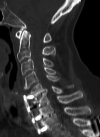Failure in Cervical Spinal Fusion and Current Management Modalities
- PMID: 33994872
- PMCID: PMC8110352
- DOI: 10.1055/s-0041-1722853
Failure in Cervical Spinal Fusion and Current Management Modalities
Abstract
Failed fusion in the cervical spine is a multifactorial problem stemming from a combination of patient and surgical factors. Patient-related risk factors such as steroid use, poor bone quality, and smoking can be optimized preoperatively. Age, prior radiation, prior surgery, and underlying genetics are nonmodifiable patient-centered risk factors. Surgical risks for failed fusion include the number of segments fused, anterior versus posterior approach for fusion, the type of bone graft, and the instrumentation utilized. Many symptomatic cases of failed fusion (pseudarthrosis) result in pain, neurological deficits, or loosened hardware necessitating a revision surgery consisting of extending the prior construct and utilizing additional allografts or autografts to augment the fusion. Given the relatively mobile nature of the cervical spine, pseudoarthrosis (either known or anticipated) must be recognized by the spine surgeon, and steps should be considered to optimize the likelihood of future fusion. This consists of both performing a rigid fixation and using appropriate bone graft to enhance the environment for arthrodesis. Vascularized bone grafts are a useful tool to augment fusion and provide added structural stability in cases at high risk of pseudoarthrosis.
Keywords: cervical pseudarthrosis; neurosurgery; plastic surgery; spine surgery; spinoplastic reconstruction.
Thieme. All rights reserved.
Conflict of interest statement
Conflict of Interest Dr. Ropper receives consulting fees from Globus Medical and Stryker, but they have no conflict with this report.
Figures


Similar articles
-
Vascularized Bone Grafts for Spinal Fusion-Part 3: The Occiput.Oper Neurosurg. 2021 Apr 15;20(5):502-507. doi: 10.1093/ons/opab036. Oper Neurosurg. 2021. PMID: 33609121 Review.
-
Vascularized Posterior Iliac Crest Bone Grafting: Indications, Techniques, Clinical Outcomes, and Alternatives.Semin Plast Surg. 2021 Feb;35(1):37-40. doi: 10.1055/s-0041-1725986. Epub 2021 May 10. Semin Plast Surg. 2021. PMID: 33994877 Free PMC article. Review.
-
Vascularized Bone Grafts for Spinal Fusion-Part 4: The Scapula.Oper Neurosurg. 2021 Apr 15;20(5):508-512. doi: 10.1093/ons/opab034. Oper Neurosurg. 2021. PMID: 33616164
-
An outcomes analysis of the treatment of cervical pseudarthrosis with posterior fusion.Spine (Phila Pa 1976). 2005 Nov 1;30(21):2424-9. doi: 10.1097/01.brs.0000184314.26543.7d. Spine (Phila Pa 1976). 2005. PMID: 16261120
-
Pedicled, vascularized occipital bone graft to supplement atlantoaxial arthrodesis for the treatment of pseudoarthrosis.J Clin Neurosci. 2020 Apr;74:205-209. doi: 10.1016/j.jocn.2019.04.014. Epub 2019 Apr 26. J Clin Neurosci. 2020. PMID: 31036507
Cited by
-
Complications in Spinal Fusion Surgery: A Systematic Review of Clinically Used Cages.J Clin Med. 2022 Oct 25;11(21):6279. doi: 10.3390/jcm11216279. J Clin Med. 2022. PMID: 36362508 Free PMC article. Review.
-
Cervical Vertebra Bone Quality Score Predicts Zero-Profile Anchored Spacer Interbody Fusion Cage Subsidence after Anterior Cervical Diskectomy and Fusion: A Retrospective Study.Global Spine J. 2025 May;15(4):2020-2031. doi: 10.1177/21925682241280258. Epub 2024 Aug 31. Global Spine J. 2025. PMID: 39216843 Free PMC article.
-
Transforming spinal surgery with innovations in biologics and additive manufacturing.Mater Today Bio. 2025 May 13;32:101853. doi: 10.1016/j.mtbio.2025.101853. eCollection 2025 Jun. Mater Today Bio. 2025. PMID: 40487177 Free PMC article. Review.
-
Robot-assisted technique versus freehand technique for spine surgery: an umbrella review.Ann Med. 2025 Dec;57(1):2523564. doi: 10.1080/07853890.2025.2523564. Epub 2025 Jul 9. Ann Med. 2025. PMID: 40631354 Free PMC article.
-
Improvement in Spine Pain, Functional Performance, and Quality of Life in a 26-Year-Old Male With a Failed Spine Fusion Surgery After Chiropractic BioPhysics® Structural Spinal Rehabilitation: A Case Report With a Six-Month Follow-Up.Cureus. 2024 Oct 15;16(10):e71544. doi: 10.7759/cureus.71544. eCollection 2024 Oct. Cureus. 2024. PMID: 39417063 Free PMC article.
References
-
- Saifi C, Fein A W, Cazzulino A. Trends in resource utilization and rate of cervical disc arthroplasty and anterior cervical discectomy and fusion throughout the United States from 2006 to 2013. Spine J. 2018;18(06):1022–1029. - PubMed
-
- Pennington Z, Mehta V A, Lubelski D. Quality of life and cost implications of pseudarthrosis after anterior cervical discectomy and fusion and its subsequent revision surgery. World Neurosurg. 2020;133:e592–e599. - PubMed
-
- Lowery G L, Swank M L, McDonough R F. Surgical revision for failed anterior cervical fusions. Articular pillar plating or anterior revision? Spine. 1995;20(22):2436–2441. - PubMed
-
- Cannada L K, Scherping S C, Yoo J U, Jones P K, Emery S E. Pseudoarthrosis of the cervical spine: a comparison of radiographic diagnostic measures. Spine. 2003;28(01):46–51. - PubMed
-
- Phillips F M, Carlson G, Emery S E, Bohlman H H. Anterior cervical pseudarthrosis. Natural history and treatment. Spine. 1997;22(14):1585–1589. - PubMed
Publication types
LinkOut - more resources
Full Text Sources
Other Literature Sources
Medical

